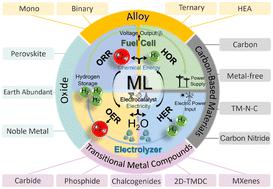当前位置:
X-MOL 学术
›
Chem. Soc. Rev.
›
论文详情
Our official English website, www.x-mol.net, welcomes your
feedback! (Note: you will need to create a separate account there.)
Unlocking the potential: machine learning applications in electrocatalyst design for electrochemical hydrogen energy transformation
Chemical Society Reviews ( IF 40.4 ) Pub Date : 2024-10-09 , DOI: 10.1039/d4cs00844h Rui Ding, Junhong Chen, Yuxin Chen, Jianguo Liu, Yoshio Bando, Xuebin Wang
Chemical Society Reviews ( IF 40.4 ) Pub Date : 2024-10-09 , DOI: 10.1039/d4cs00844h Rui Ding, Junhong Chen, Yuxin Chen, Jianguo Liu, Yoshio Bando, Xuebin Wang

|
Machine learning (ML) is rapidly emerging as a pivotal tool in the hydrogen energy industry for the creation and optimization of electrocatalysts, which enhance key electrochemical reactions like the hydrogen evolution reaction (HER), the oxygen evolution reaction (OER), the hydrogen oxidation reaction (HOR), and the oxygen reduction reaction (ORR). This comprehensive review demonstrates how cutting-edge ML techniques are being leveraged in electrocatalyst design to overcome the time-consuming limitations of traditional approaches. ML methods, using experimental data from high-throughput experiments and computational data from simulations such as density functional theory (DFT), readily identify complex correlations between electrocatalyst performance and key material descriptors. Leveraging its unparalleled speed and accuracy, ML has facilitated the discovery of novel candidates and the improvement of known products through its pattern recognition capabilities. This review aims to provide a tailored breakdown of ML applications in a format that is readily accessible to materials scientists. Hence, we comprehensively organize ML-driven research by commonly studied material types for different electrochemical reactions to illustrate how ML adeptly navigates the complex landscape of descriptors for these scenarios. We further highlight ML's critical role in the future discovery and development of electrocatalysts for hydrogen energy transformation. Potential challenges and gaps to fill within this focused domain are also discussed. As a practical guide, we hope this work will bridge the gap between communities and encourage novel paradigms in electrocatalysis research, aiming for more effective and sustainable energy solutions.
中文翻译:

释放潜力:机器学习在电化学氢能转换电催化剂设计中的应用
机器学习 (ML) 正迅速成为氢能行业中用于创造和优化电催化剂的关键工具,电催化剂可增强关键的电化学反应,如析氢反应 (HER)、析氧反应 (OER)、氢氧化反应 (HOR) 和氧还原反应 (ORR)。这篇全面的综述展示了如何在电催化剂设计中利用尖端的 ML 技术来克服传统方法耗时的局限性。ML 方法使用来自高通量实验的实验数据和来自密度泛函理论 (DFT) 等模拟的计算数据,很容易识别电催化剂性能和关键材料描述符之间的复杂相关性。凭借其无与伦比的速度和准确性,ML 通过其模式识别功能促进了新候选产品的发现和已知产品的改进。本综述旨在以材料科学家易于访问的格式提供 ML 应用程序的定制细分。因此,我们通过针对不同电化学反应的常用研究材料类型全面组织了 ML 驱动的研究,以说明 ML 如何熟练地驾驭这些场景的复杂描述符景观。我们进一步强调了 ML 在未来发现和开发用于氢能转化的电催化剂中的关键作用。还讨论了在这个重点领域中需要填补的潜在挑战和空白。作为实用指南,我们希望这项工作能够弥合社区之间的差距,并鼓励电催化研究的新范式,旨在实现更有效和可持续的能源解决方案。
更新日期:2024-10-11
中文翻译:

释放潜力:机器学习在电化学氢能转换电催化剂设计中的应用
机器学习 (ML) 正迅速成为氢能行业中用于创造和优化电催化剂的关键工具,电催化剂可增强关键的电化学反应,如析氢反应 (HER)、析氧反应 (OER)、氢氧化反应 (HOR) 和氧还原反应 (ORR)。这篇全面的综述展示了如何在电催化剂设计中利用尖端的 ML 技术来克服传统方法耗时的局限性。ML 方法使用来自高通量实验的实验数据和来自密度泛函理论 (DFT) 等模拟的计算数据,很容易识别电催化剂性能和关键材料描述符之间的复杂相关性。凭借其无与伦比的速度和准确性,ML 通过其模式识别功能促进了新候选产品的发现和已知产品的改进。本综述旨在以材料科学家易于访问的格式提供 ML 应用程序的定制细分。因此,我们通过针对不同电化学反应的常用研究材料类型全面组织了 ML 驱动的研究,以说明 ML 如何熟练地驾驭这些场景的复杂描述符景观。我们进一步强调了 ML 在未来发现和开发用于氢能转化的电催化剂中的关键作用。还讨论了在这个重点领域中需要填补的潜在挑战和空白。作为实用指南,我们希望这项工作能够弥合社区之间的差距,并鼓励电催化研究的新范式,旨在实现更有效和可持续的能源解决方案。






























 京公网安备 11010802027423号
京公网安备 11010802027423号